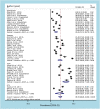Breast self-examination practice and its determinants among women in Ethiopia: A systematic review and meta-analysis
- PMID: 33444380
- PMCID: PMC7808636
- DOI: 10.1371/journal.pone.0245252
Breast self-examination practice and its determinants among women in Ethiopia: A systematic review and meta-analysis
Abstract
Background: The survival rate from breast cancer is lowest in African countries and the distribution of breast self-examination practice of and its determinants are not well investigated in Ethiopia. Therefore, this systematic review and meta-analysis was designed to determine the pooled prevalence of breast self-examination and its associated factors among women in Ethiopia.
Methods: Preferred Reporting Items for Systematic Reviews and Meta-Analyses (PRISMA) guideline was followed for this systematic review and meta-analysis. The databases used were; PUBMED, Cochrane Library, Google Scholar, CINAHL, African Journals Online, Dimensions and Summon per country online databases. Search terms used were; breast self-examination, breast cancer screening, early detection of breast cancer and Ethiopia. Joanna Briggs Institute Meta-Analysis of Statistics Assessment and Review Instrument (JBI-MAStARI) was used for critical appraisal of studies. The meta-analysis was conducted using STATA 15 software. The pooled meta-analysis was computed to present the pooled prevalence and relative risks (RRs) of the determinate factors with 95% confidence intervals (CIs).
Results: We identified 2,637 studies, of which, 40 articles (with 17,820 participants) were eligible for inclusion in the final meta-analysis. The pooled estimate of breast self-examination in Ethiopia was 36.72% (95% CI: 29.90, 43.53). The regional distribution breast self-examination ranged from 21.2% (95% CI: 4.49, 37.91) in Tigray to 61.5% (95% CI: 53.98, 69.02) in Gambela region. The lowest prevalence of breast self-examination was observed among the general population (20.43% (95% CI: 14.13, 26.72)). Women who had non-formal educational status (OR = 0.4 (95% CI: 0.21, 0.77)), family history of breast cancer (OR = 2.04 (95% CI: 1.23, 3.39)), good knowledge of breast self-examination (OR = 4.8 (95% CI: 3.03, 7.6)) and favorable attitude toward breast self-examination (OR = 2.75, (95% CI: 1.66, 4.55)) were significantly associated with practice of breast self-examination.
Conclusions: Only a third of women in Ethiopia practiced breast examination despite WHO guidelines advocating for this practice among all women of reproductive age. Intervention programs should address the factors that are associated with breast self-examination. Population specific programs are needed to promote breast self-examination.
Conflict of interest statement
The authors have declared that no competing interests exist.
Figures








Similar articles
-
Prevalence and determinants of anemia among pregnant women in Ethiopia; a systematic review and meta-analysis.BMC Hematol. 2017 Oct 17;17:17. doi: 10.1186/s12878-017-0090-z. eCollection 2017. BMC Hematol. 2017. PMID: 29075500 Free PMC article.
-
Mother-to-child transmission of HIV infection and its associated factors in Ethiopia: a systematic review and meta-analysis.BMC Infect Dis. 2018 May 10;18(1):216. doi: 10.1186/s12879-018-3126-5. BMC Infect Dis. 2018. PMID: 29747581 Free PMC article.
-
Breast self-examination practice and associated factors among female healthcare workers in Ethiopia: A systematic review and meta-analysis.PLoS One. 2020 Nov 10;15(11):e0241961. doi: 10.1371/journal.pone.0241961. eCollection 2020. PLoS One. 2020. PMID: 33170880 Free PMC article.
-
Birth preparedness and complication readiness among pregnant women in Ethiopia: a systematic review and Meta-analysis.Reprod Health. 2018 Oct 29;15(1):182. doi: 10.1186/s12978-018-0624-2. Reprod Health. 2018. PMID: 30373598 Free PMC article.
-
Breast self-examination practice among women in Africa: a systematic review and Meta-analysis.Arch Public Health. 2021 Aug 21;79(1):149. doi: 10.1186/s13690-021-00671-8. Arch Public Health. 2021. PMID: 34419150 Free PMC article. Review.
Cited by
-
Breast Self-Examination: Evaluating Knowledge, Attitudes, and Practices Among Female Medical Students.Cureus. 2025 Jun 20;17(6):e86419. doi: 10.7759/cureus.86419. eCollection 2025 Jun. Cureus. 2025. PMID: 40688879 Free PMC article.
-
Determinants of breast cancer in Ethiopia: a systematic review and meta-analysis.Ecancermedicalscience. 2023 Nov 10;17:1624. doi: 10.3332/ecancer.2023.1624. eCollection 2023. Ecancermedicalscience. 2023. PMID: 38414952 Free PMC article. Review.
-
Determinants of breast self-examination practice among women attending pastoralist health facilities, Southern Ethiopia: a cross-sectional study.BMC Womens Health. 2023 Jan 11;23(1):14. doi: 10.1186/s12905-023-02158-w. BMC Womens Health. 2023. PMID: 36627644 Free PMC article.
-
What is the uptake rate of breast self-examination in Iranian women? Estimation based on systematic review and meta-analysis.BMC Womens Health. 2023 Oct 17;23(1):538. doi: 10.1186/s12905-023-02688-3. BMC Womens Health. 2023. PMID: 37848904 Free PMC article.
-
Breast Self-Examination Practice and Its Determinants among Women in Indonesia: A Systematic Review, Meta-Analysis, and Meta-Regression.Diagnostics (Basel). 2023 Aug 2;13(15):2577. doi: 10.3390/diagnostics13152577. Diagnostics (Basel). 2023. PMID: 37568940 Free PMC article. Review.
References
-
- World Health Organization (WHO). Global Health Observatory data repository Genva2016 [cited 2020 22/07/2020]. Available from: https://apps.who.int/gho/data/node.main.A859?lang=en.
-
- Parkin D, Bray F, Ferlay J, Jemal A. Cancer in Africa 2012. American association for cancer research 2012. - PubMed
-
- World Health Organization. Cancer Control Knowledge into Action: WHO guide for Effective Programmes. 2007. - PubMed
Publication types
MeSH terms
LinkOut - more resources
Full Text Sources
Other Literature Sources

